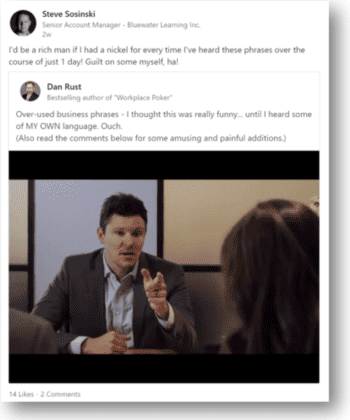Sharing content on social media is a key ingredient for social selling success. This is your best opportunity to educate, inform, entertain, and share your flair. However, it takes a little time to do it right, so follow these 8 steps to maximize your efforts:
1. Adapt to your audience
Understanding what your customers want to read is step one. Your role is to become a trusted resource and a curator of facts and knowledge that will leave a lasting impression. The goal here is for your customer to think to themselves after they read your post, ‘that was a good use of three minutes of my day.’ Let’s reverse engineer this. What type of information would create this kind of response? Everyone is busy these days and therefore they have limited time, however, they also need to be up-to-date and informed. This is where you can jump into their lives and deliver value by fulfilling these needs. Here are some items to share:
- Your subject matter expertise
- Events you are attending or have just attended (be sure to tag customers/connection who were/will be there)
- Company blog or other resources
- Industry-specific information or research
- Latest trends or fashions
- Company/industry insights
- How-to guides or explainer content
- Convert your company FAQs into posts
- Case studies or success stories that explain how to overcome industry problems
- Changes that are coming around the corner that will impact your customer
- Webinars (upcoming or archived replays)
- Videos (from your company, or ones you just like, or ones you shoot right on your phone)
- Something that will get a laugh (an appropriate laugh…nothing off-color)
- Something that will inspire or motivate
2. Resources for research
40 to 60 percent of what you share should come from you personally (sharing your experiences and subject matter expertise) and from resources provided by your company (blog articles, product information, case studies, webinars, etc.). That leaves about half for “freestyling” and curating interesting items you discover on the web to share with your audience. Here are some useful tools for finding fun and informative items:
- Google Alerts – Google Alerts allows you to monitor the web for interesting new content as it happens or to receive updates daily or weekly right in your inbox. Sources include news, blogs, and video content.
- Google search – Tried and true tool for discovering all kinds of useful (and sometimes useless) information. Use Google’s search tools to find more recent content.
- Pocket – Now that you have good places to source content, you will need useful tools to help you save the content you like most for posting in the future. Pocket is a great place to store content for later. It also has a search engine so you can discover other content saved by users.
- Pinterest – Like Pocket you can save, organize, and discover content.
- YouTube – YouTube is the 2nd largest search engine and a great place to look for interesting videos. I’m a big fan of TED Talks and can always find an interesting one to share. However, YouTube is also a great place to curate and save content. Did you know that you can create playlists on YouTube that include videos you like? They don’t have to be videos you create. Therefore, like Pocket or Pinterest, you can discover new content and save it to share at a later date in a playlist. We have a few playlists on our channel that might inspire you.
3. Fire up your flair
People do business with people they know, like, and trust so don’t be afraid to let your personality shine through in your posts. Share your opinions and thoughts on topics. The goal isn’t to be watered down to appeal to everyone, but rather to connect with people who appreciate your unique flair. In fact, it’s your uniqueness that will make you stand out and resonate with your audience.
4. Constant Content
How often should you post? Shoot for once a day, but even one or two times per week is a great start.
5. Harness the Hashtag
Hashtags are words connected to a # (for example #SocialSelling) and allow users to click the hashtag and discover other content with the same hashtag. Using hashtags will allow new people to discover your content. While most platforms allow hashtags, they work exceptionally well on Twitter and Instagram. Hashtag Tracker is a good resource for discovering hashtags you might want to use in your posts.
6. Location, Location, Location
Where should you post? Obviously, you need to be active in a social platform to post there. However, it depends on where your customers like to hang out and also your personal preferences. Here is a guide to get you started:
- B2B – LinkedIn & Twitter
- Retail – Instagram & Facebook (feel free to post on your Facebook profile and have customers as friends. However, your personal page is not a place to be promotional)
- B2C – Facebook, LinkedIn, Instagram
7. Finding the Perfect Picture
Often the posts that you share will include images for your social post. However, sometimes you will need to find or create an image. Here are some options to consider:
- Take a picture with your phone. Some of my most engaged posts came from images I took with my phone.
- Use free photo sharing sites like Grastisography and Pixabay.
- Don’t use Google images! These images are copyright protected and you can get it trouble if you use them without a license.
8 Don’t Think You’re Done
Posting is just the beginning of the story and is like putting a stake in the ground and saying “Here it is! Let me know what you think and if you like it!” If you follow these steps, guess what, people will actually react to the content you share. Now the fun begins. In most cases, reactions will be comments, likes, shares/retweets.
- Comments; always reply to comments on your posts. If possible, end the comment with a question to try to keep the conversation going.
- Likes; a good way to learn what content is working best with your followers is to monitor the number of likes your post receives. However, it’s ok to thank the person who liked your post as a comment and tag them in (for example, “@Name thanks for liking my post! What part/part/point was the most valuable to you?”
- Shares/retweets; more valuable than likes because the user actually shared it with their followers. Post a comment and tag them in as well.
Silence is not golden in social media. Sharing content is the way to be seen, found, and appreciated – if you do it the right way. It’s about educating, informing, and entertaining your audience with your own personal flair. Follow these 8 steps and take the time to do it right and you’ll be happy with the results. Happy Social Selling!


